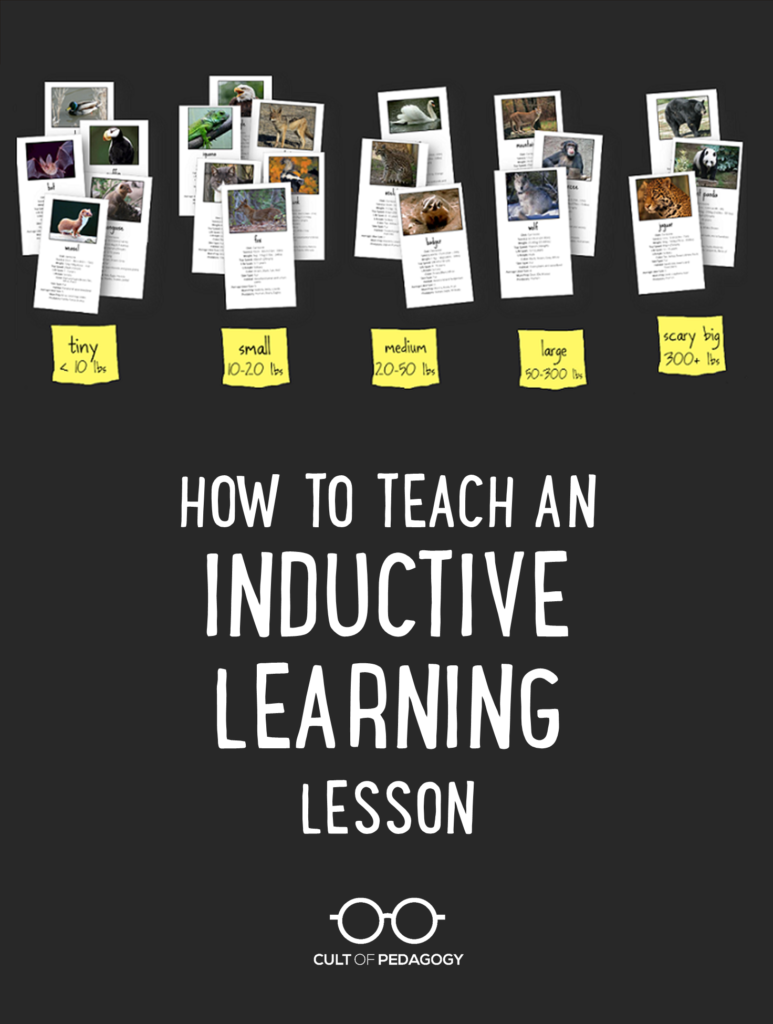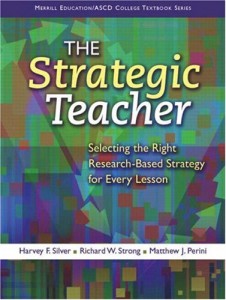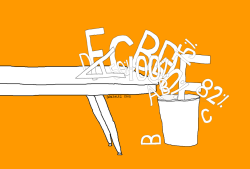
This easy strategy, loaded with higher-order thinking, lets students get their hands on the content without further ado.
Sure, you’ve heard that we shouldn’t just spoon-feed information to our students, but what exactly should we be doing instead?
One possibility is inductive learning.
Inductive learning takes the traditional sequence of a lesson and reverses things. Instead of saying, “Here is the knowledge; now go practice it,” inductive learning says, “Here are some objects, some data, some artifacts, some experiences…what knowledge can we gain from them?”
A number of instructional approaches, including discovery learning, inquiry-based learning, and problem-based learning, could be considered inductive, and all of them are well-supported by research. If you’re just getting started with inductive learning, take a look at the video below, where we break down a very simple inductive strategy, one that takes less time and requires less planning than something like a PBL unit. It’s a method that can work with very simple concepts, like parts of speech, or more complex ones, like systems of government, and it would be appropriate for just about any grade level.
Dig it:
[Want to make videos like this? Learn more here.]
This strategy comes from a book I can’t seem to get enough of: The Strategic Teacher
, by Silver, Strong, and Perini. This is the fourth research-based teaching strategy we’ve studied up close.
Try it and let me know how it goes. Or if you’ve already used this strategy or something like it and have finer points to share with the rest of us, please do. Happy teaching y’all. ♦
If this one spoke to you, I’d love to have you come back for more. Join my mailing list and get weekly tips, tools, and inspiration — in quick, bite-sized packages — all geared toward making your teaching more effective and joyful. To thank you, I’ll send you a free copy of my new e-booklet, 20 Ways to Cut Your Grading Time in Half. I look forward to getting to know you better!






I am a HS chemistry teacher always looking for different methods to introduce, teach, and review for my students. I use a lot of technology in the classroom, as the school in which I teach is a `1:1 iPad school, but sometimes it is nice to shut the technology off.
Look into Modeling chemistry. It changed my entire approach to taxing chemistry. The first year was hard because students REALLY resisted. I had a phenomenal support teacher in my room most days who was my “cheerleader” and didn’t let me throw in the towel. I LOVE teaching again and can easily do this another 20 years.
Could you share details about modeling chemistry. Because I need to change up how I’m doing things in science. And I would like to feel that I want to teach 20 more years!
This is how I have taught the majority of my concepts for years–even grammar. The kids love it and I love watching them figure things out. Thanks for the good information. I hope others jump on board.
Do these cards already exist in a form that is downloadable (i’m imagining at a cost)? I teach HS Bio and am back in the classroom for the first time in 13 years!!! This is such a great way to teach classification and a great way to get the kids communicating!!
Unfortunately, no. I just put them together for the purposes of the video, but because I used a few images from other websites where I wouldn’t have had permission to re-distribute them for sale, I never turned them into an actual product. I would recommend you look at some of the products from Getting Nerdy with Mel and Gerdy or Kesler Science; both have excellent stuff!
Hi Ms. Jennifer Gonzales, Thank you for sharing your knowledge to us. It was really helpful especially for the students like me who is studying education. I just want to ask some suggestion if I were to use inductive method as an approach what is the best topic I should consider? By the way I am social studies teacher.
Thank you.
Totally agree with you about “The Strategic Teacher…!” It is the best book on teaching strategies I’ve read!
I do not know what social studies discipline Sharia teaches, but I teach middle school history. Tomorrow, I will be doing an inductive thinking lesson that I put together on the legacies of Rome. Rather than using words, the kids categorize pictures.
BTW, another strategy from the Silver book that uses the inductive learning method that you might explain to your readers is “Mystery.” I use Mystery in every unit.
Thanks so much for this, Mike! I gave a workshop not too long ago where I taught this strategy, and I was really stumped when a teacher asked me how she could use it in 8th grade social studies. This helps! If you get a chance, I would love to hear more about what the pictures contain and what the kids come up with.
I did this today with my 9th graders to introduce Christianity in the Roman Empire. I gave them 25 cards that had terms, maps and pictures representing Christianity, Judaism, Hinduism and Buddhism. Some kids immediately noticed there were four separate religions a few groups grouped rituals, beliefs and maps. The whole process took about 25 minutes and they used the remainder of the time to complete a task of their choice (a word web about golden ages, a caricature (https://sites.google.com/a/pvlearners.net/apushkjo/the-team/apush-projects), or a vocabulary practice). Tomorrow we’ll get into the beliefs and practices of Christianity and how at first this collided with Roman thinking.
Hello Jennifer,
Sorry that it took me several years to get back to you! 🙁 I had not visited this page for quite a while, and just noticed your question.
Because I taught history, I often used primary source quotes when I used an inductive learning component to a lesson. For example, on a lesson on Pompeii, students did the grouping and labeling with 22 inscriptions that were found on the walls of the Pompeii (in addition they had 12 pictures of things found at the site) to form generalizations about life in an ancient Roman city. In a lesson on the Black Death, teams used primary source quotes from medieval people to form inferences about what medieval people thought caused the plague, and how they tried to stop it (actually this lesson used the Mystery strategy; inductive learning’s cousin).
Sorry it took so long to get back to you!
Hey Mike! Good to hear from you – I’ll be sure to let Jenn know. In the meantime, thanks so much for sharing this!
Just attended conference with Harvey Silver the other day. Amazing!
I just came across your blog and I am just wondering if you ever read the research that these teaching methods are based on? I listen to a lot of economic podcasts and they always talk about studies and the validity of them. What makes a study good or what makes a study bad. I find that when I look at the studies that are for teaching they are almost always bad studies. Sample size too small, sample size homogeneous, study was based off of a questionnaire or survey instead of scientific observation or the study doesn’t have a control group. Often times too I will find a misleading headline that was pulled from the study and exaggerated to support a claim. Then when you read the study it says something similar but not so spectacular. Love the podcast.
This cult is absolutely amazing. Thank you ALL for sharing ! I love the information, sharing…so fantastically rejuvenating! LOVE ❤️ and love it!
Hello dear Jennifer
I saw your valuable works for the first time. I’m a lecturer of teacher education students in the university and I have about twenty-five years of experience working with new teachers who are eager to learn active teaching methods in the classroom. Your work is excellent and appreciated. I will follow you curiously.
Thank you, Jamileh. We are glad you enjoy the posts!